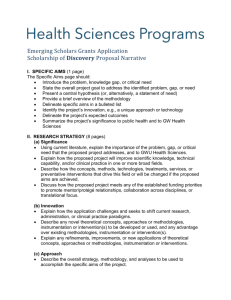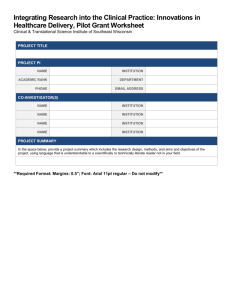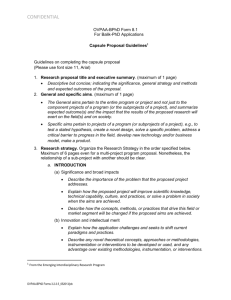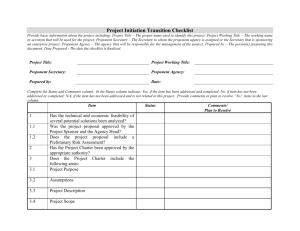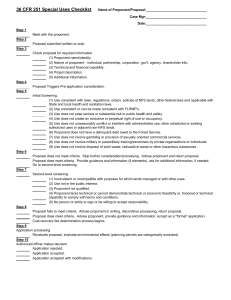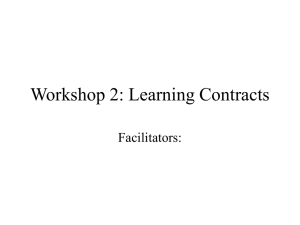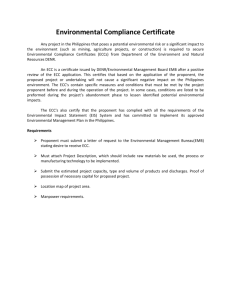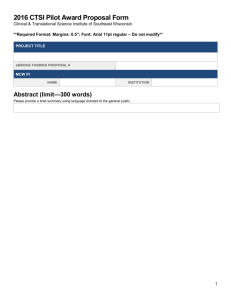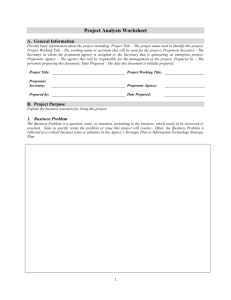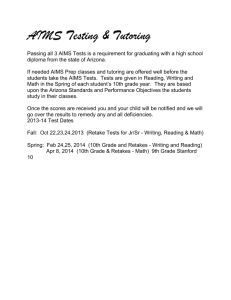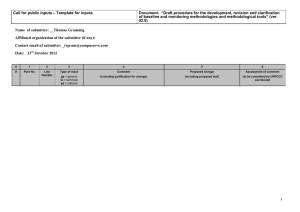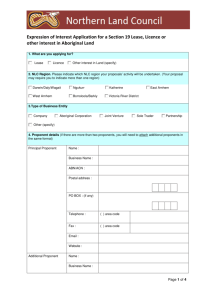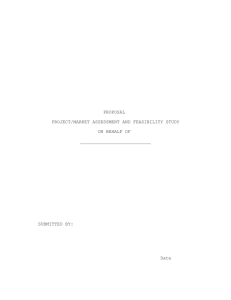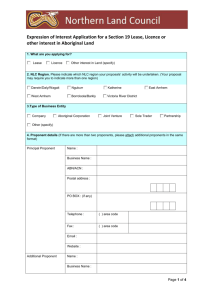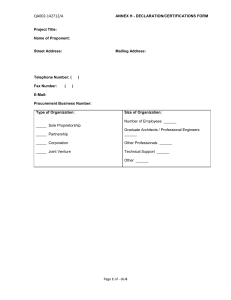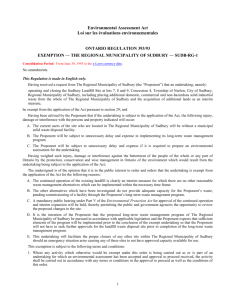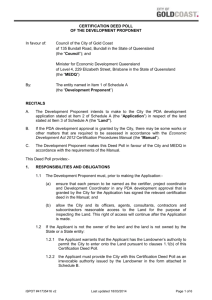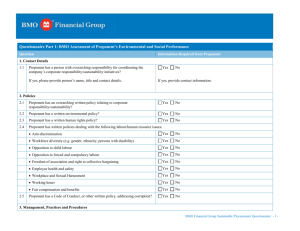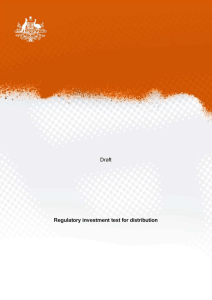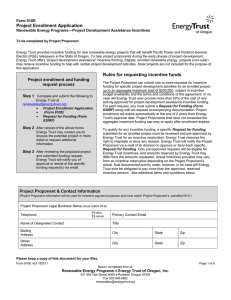EIDR-Form-3.3_Capsule Proposal Guidelines
advertisement
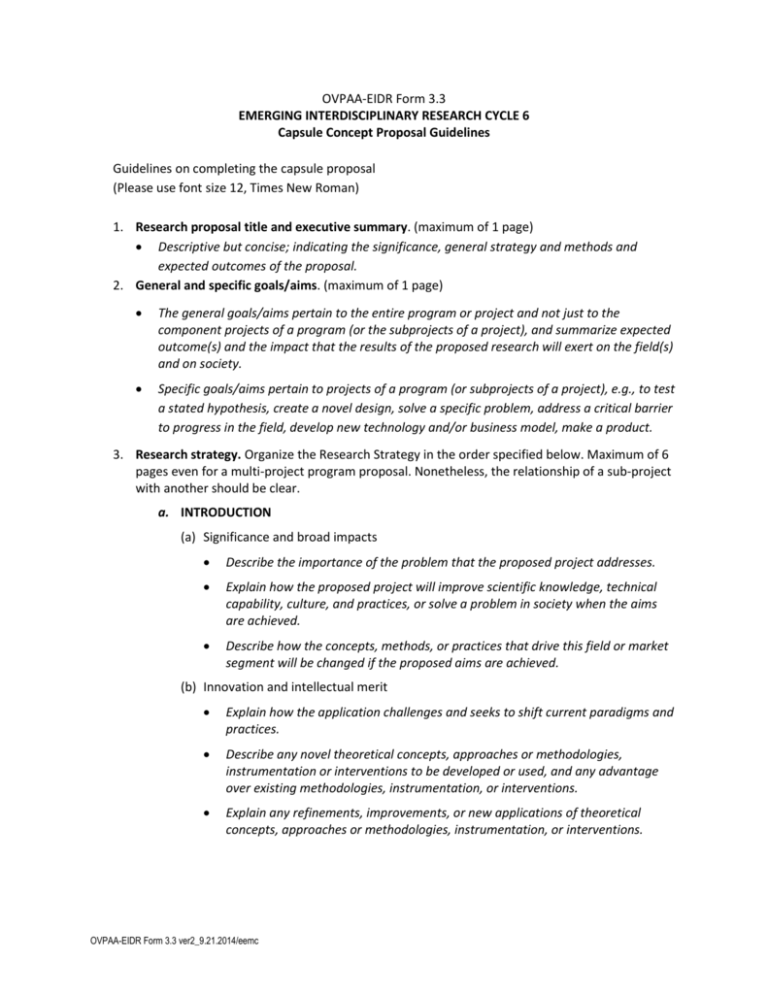
OVPAA-EIDR Form 3.3 EMERGING INTERDISCIPLINARY RESEARCH CYCLE 6 Capsule Concept Proposal Guidelines Guidelines on completing the capsule proposal (Please use font size 12, Times New Roman) 1. Research proposal title and executive summary. (maximum of 1 page) Descriptive but concise; indicating the significance, general strategy and methods and expected outcomes of the proposal. 2. General and specific goals/aims. (maximum of 1 page) The general goals/aims pertain to the entire program or project and not just to the component projects of a program (or the subprojects of a project), and summarize expected outcome(s) and the impact that the results of the proposed research will exert on the field(s) and on society. Specific goals/aims pertain to projects of a program (or subprojects of a project), e.g., to test a stated hypothesis, create a novel design, solve a specific problem, address a critical barrier to progress in the field, develop new technology and/or business model, make a product. 3. Research strategy. Organize the Research Strategy in the order specified below. Maximum of 6 pages even for a multi-project program proposal. Nonetheless, the relationship of a sub-project with another should be clear. a. INTRODUCTION (a) Significance and broad impacts Describe the importance of the problem that the proposed project addresses. Explain how the proposed project will improve scientific knowledge, technical capability, culture, and practices, or solve a problem in society when the aims are achieved. Describe how the concepts, methods, or practices that drive this field or market segment will be changed if the proposed aims are achieved. (b) Innovation and intellectual merit Explain how the application challenges and seeks to shift current paradigms and practices. Describe any novel theoretical concepts, approaches or methodologies, instrumentation or interventions to be developed or used, and any advantage over existing methodologies, instrumentation, or interventions. Explain any refinements, improvements, or new applications of theoretical concepts, approaches or methodologies, instrumentation, or interventions. OVPAA-EIDR Form 3.3 ver2_9.21.2014/eemc b. STRATEGY AND METHODOLOGIES Describe the overall strategy and the general methodologies to be used to accomplish the specific aims of the project. Where applicable, include how data will be collected, analyzed, and interpreted as well as any resource sharing plans as appropriate. Discuss potential problems, alternative strategies, and benchmarks for success anticipated to achieve the aims. Describe any strategy to establish feasibility (to complete the project within the proposed period), and address the management of any high risk aspects of the proposed work, especially if the project is in the early stages of development. Describe clearly the role and functions of the program operations manager in relation to the Main proponent, co-proponents, and various aspects of the proposal. Indicate any procedures, situations, or materials that may be hazardous to personnel and precautions to be exercised. Indicate ethics reviews and all permits required to pursue the projects. Describe how the project’s results will be leveraged to obtain financing for the project’s continuation beyond the duration of the grant. c. EXPECTED OUTPUT, OUTCOMES, DELIVERABLES (a) Output for Society Products (e.g., nutraceuticals, diagnostic kit, software) Services (e.g., food safety tasting, training course) Process (e.g., clothing design, technology improvement) Systems (e.g., waste recycling system) (b) Academic Output Publication in an ISI- or SCOPUS-listed journal or proof of unconditional acceptance of a manuscript for publication in an ISI- or SCOPUS-listed journal Book or book chapter for publication by an academic press or publisher as provided in the International Publication Award list of accepted publishers Patent or patent application Laboratory manuals Experimental protocol d. GANTT CHART (1 Chart for a multi-project program proposal, e.g., where the output of one project is the input of another should appear clearly in the Chart.) Include other types of relational diagrams, organizational and process charts Include a general program/project management and implementation diagram OVPAA-EIDR Form 3.3 ver2_9.21.2014/eemc Gantt Chart (Sample) Project Title: Planned Start: Total Duration (in months): __________ Month _______ Year _____ Activities Year 1 Year 2 Expected Objectives or Q1 Q2 Q3 Q4 Q1 Q2 Q3 Q4 Output * Workplan Planned End: Month ________ Year _____ Year 3 Year 4 Q1 Q2 Q3 Q4 Q1 Q2 Q3 Q4 * Quantify if possible, e.g. Improved yield (quantify/volume/ unit/area). Compare with existing technologies. Scheme and Relational Diagram Sample Hub and Spokes organizational structure OVPAA-EIDR Form 3.3 ver2_9.21.2014/eemc 4. Other funding and other projects. a. List all other existing funded projects related to this project: program or project title, proponents and collaborators, funding source, amount of funding, funding period. b. Explain clearly how this proposal relates to the above funded projects. c. List all other funded projects not related to this project; indicate amount of funding and funding source. d. Indicate RLC (Research Load Credit in the last year for existing projects.) 5. Bibliography. List of references used in the preparation of this document (including the Review of Literature). (PubMed format) Example: Meneton P, Jeunemaitre X, de Wardener HE, MacGregor GA. Links between dietary salt intake, renal salt handling, blood pressure, and cardiovascular diseases. Physiol Rev. 2005 Apr; 85(2):679-715. 6. Proponent profiles. Each proponent (main and co-proponents, operations manager) submits a Biosketch (maximum 2 pages) containing the following: a. Educational background (BS, MS, PhD, postdoctoral training): degree, major or specialization, university, graduation/completion date b. One paragraph written by each proponent explaining why he/she is competent to be a proponent of this proposal. c. List of 5-8 publications of the proponent that demonstrates the expertise and competence of the proponent to lead and conduct this particular research. d. State if there is any or no personal or group conflicts of interest in conducting this research. e. Suggest local and international experts who can serve as external reviewers of this proposal; indicate those who should not review the proposal. 7. Attachments a. Review of Literature (1 Review for a multi-project proposal). Review should clearly indicate sections pertaining to each project of the program and the interdisciplinary integration. Review must cite important and relevant references. b. Net Present Value (for business projects).Include a projection of net present value for the capsule proposal. A detailed business plan and market study will be required for the full proposal. c. Proposed budget (OVPAA-EIDR Form 3.5). The personnel rates in the sample budget are indicative rates and will be refined for the full proposal. For the IDR program proposal, the grant is up to ~P2.5M per project or P10M per program (consisting of 4 projects) per year for a period of 2 years. The program is renewable for another 2 years. For the start-up grant for a new local PhD graduate, the grant is up to P2.5M for a one-year project. d. Other project information. Indicate if there is proprietary information on the project and include facilities, required certification and list of equipment. OVPAA-EIDR Form 3.3 ver2_9.21.2014/eemc
